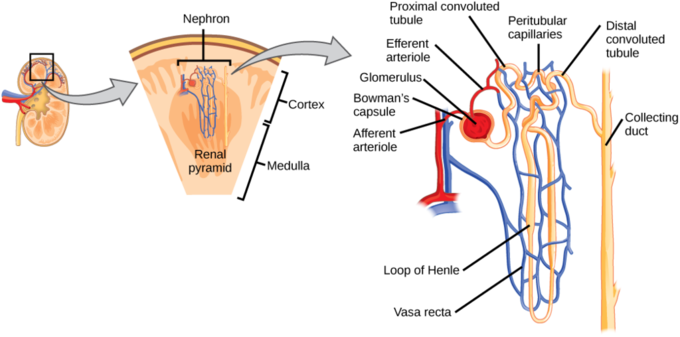41.11: Human Osmoregulatory and Excretory Systems - Nephron- The Functional Unit of the Kidney
- Page ID
- 14078
- Explain the role of the nephron as the functional unit of the kidney
The nephron, the functional unit of the kidney, is responsible for removing waste from the body. Each kidney is composed of over one million nephrons that dot the renal cortex, giving it a granular appearance when sectioned sagittally (from front to rear). Eighty-five percent of nephrons are cortical nephrons, deep in the renal cortex; the remaining 15 percent are juxtamedullary nephrons, which lie in the renal cortex close to the renal medulla.

Diagram of a nephron
The nephron is the functional unit of the kidney. The glomerulus and convoluted tubules of the nephron are located in the cortex of the kidney, while the collecting ducts are located in the pyramids of the kidney’s medulla.
A nephron consists of three parts: a renal corpuscle, a renal tubule, and the associated capillary network, which originates from the cortical radiate arteries. The renal corpuscle, located in the renal cortex, is composed of a network of capillaries known as the glomerulus, as well as a cup-shaped chamber that surrounds it: the glomerular or Bowman’s capsule.
The renal tubule is a long, convoluted structure that emerges from the glomerulus. It can be divided into three parts based on function. The first part is called the proximal convoluted tubule (PCT), due to its proximity to the glomerulus. The second part is called the loop of Henle, or nephritic loop, because it forms a loop (with descending and ascending limbs) that goes through the renal medulla. The third part of the renal tubule is called the distal convoluted tubule (DCT); this part is also restricted to the renal cortex. This last part of the nephron connects with and empties its filtrate into collecting ducts that line the medullary pyramids. The collecting ducts amass contents from multiple nephrons, fusing together as they enter the papillae of the renal medulla.
As urine travels down the collecting duct system, it passes by the medullary interstitium, which has a high sodium concentration as a result of the loop of Henle’s countercurrent multiplier system. Urine leaves the medullary collecting ducts through the renal papillae, emptying into the renal calyces, the renal pelvis, and finally into the bladder via the ureter.
Key Points
- Kidneys contain two types of nephrons, each located in different parts of the renal cortex: cortical nephrons and juxtamedullary nephrons.
- A nephron comprises a renal corpuscle, a renal tubule, and the associated capillary network.
- Internally, kidneys are mainly composed of over one million nephrons and an extensive network of blood vessels and capillaries.
Key Terms
- glomerulus: A small intertwined group of capillaries within a kidney’s nephron that filters the blood to make urine.
- loop of Henle: A structure in a kidney’s nephron that connects the proximal convoluted tubule to the distal convoluted tubule.


